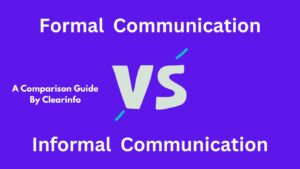Definition of business communication
According to Mary Ellen Guffey, “Business communication is the process of creating and conveying a message that is meaningful to the sender and the receiver with the purpose of achieving a desired outcome.”
As defined by Murphy and Hildebrandt, “Business communication is the sharing of information between people within and outside an organization for the purpose of achieving organizational goals.”
What is business communication?
Business communication is the process of sharing information and messages within an organization and with external stakeholders such as customers and suppliers. The core objective of business communication is to promote a clear understanding of organizational goals and ultimately contribute to the overall achievement and growth of the business. Effective business communication plays a crucial role in ensuring that information flows seamlessly across different levels of an organization, leading to improved productivity and a positive corporate image.
Nature of business communication
The nature of business communication is dynamic and interactive. It involves the exchange of information, ideas, and messages through various channels, such as verbal, written, digital, and nonverbal, and requires both sender and receiver to be actively involved in the communication process.
Characteristics of business communication
- Goal-oriented: Business communication is purposeful and directed towards achieving specific objectives.
- Formality: It generally follows a formal and structured tone, with attention given to language, tone, and etiquette.
- Audience-specific: Successful business communication, consider the requirements, preferences, and expectations of the target audience.
- Documented: Business communication is often documented in writing, whether in the form of emails, memos, reports, or other written materials.
To know more check out our detailed article on: Main characteristics of effective business communication
Types of business communication
The most common types of business communication include:

1/ Internal communication: Internal communication encompasses all the exchanges of information that occur within an organization. It’s a two-way process that involves listening and responding. Internal communication serves various purposes, including providing direction, sharing information, exchanging ideas, solving problems, and building relationships.
There are three main types of internal communication: upward, downward, and lateral communication.
Upward communication refers to the flow of information from the lower levels of a company hierarchy to its leaders. This exchange is facilitated through feedback mechanisms, employee surveys, and open forums.
It plays a crucial role in developing a culture of transparency where everyone feels included. By understanding the details of upward communication, management can make informed decisions that incorporate the concerns and insights of their workforce.
Downward communication refers to the transfer of information from higher levels of a company’s hierarchy to its subordinates. It encompasses a wide range of communication, from strategic directives and policy announcements to specific job instructions and feedback.
This mode of communication plays a crucial role in standardizing operations, clarifying roles and expectations, and motivating employees through clear goal-setting. When executed effectively, downward communication aligns the entire organization towards common objectives, ensuring that each member is well-informed and actively engaged in the company’s mission and values.
III. Lateral/horizontal communication:
Horizontal or lateral communication refers to the exchange of information among peers within the same hierarchical level of an organization. This type of interaction is crucial for developing collaboration among departments, teams, or individuals when it comes to aligning strategies, problem-solving, and sharing resources and best practices.
It plays a significant role in developing collaboration and cultivating a sense of unity and interdependence. Proficiency in horizontal communication is vital for streamlining cross-functional processes and maintaining organizational consistency, ensuring that diverse units operate synergistically towards shared corporate goals.
In some organization diagnonal communication can also be a part of business messaging.
Diagonal communication is the exchange of information between different levels and functional areas of an organization, bypassing the traditional hierarchical structure. This form of communication is crucial for enhancing efficiency and driving innovation by enabling frontline employees to directly connect with managers and even executives from various departments.
It connects gaps within an organization, promoting a free exchange of ideas and creating an agile and responsive business environment. Mastering diagonal communication is vital for organizations seeking to leverage diverse perspectives and speed up decision-making processes, ensuring that valuable insights from different corners of the company contribute to its overall strategic direction.
2/ External communication: External communication is the type of communication that takes place between the organization and external stakeholders, such as customers, suppliers, and business partners. Examples of external communication include:
(A) Customer/Client Communication:
When it comes to communicating with customers or clients, it’s all about building and maintaining strong relationships. This means focusing on marketing, service, and support.
By having personalized interactions, sending newsletters, using CRM systems, and gathering feedback, companies can not only keep their loyal customers happy but also attract new ones.
(B) Supplier/Vendor Communication:
Effective management of supplier and vendor relationships is crucial for smooth business operations. Clear and concise communication plays a pivotal role in maintaining an uninterrupted supply chain and negotiating favorable terms.
Utilizing tools such as purchase orders, contracts, emails, meetings, and supply chain management systems is essential for establishing and maintaining a robust communication strategy with suppliers and vendors.
(C) Investor/Shareholder Communication:
Effective communication with investors and shareholders is vital for any business, as it develops trust and showcases accountability. This aspect of external communication primarily involves sharing financial performance, key decisions, strategic visions, and corporate governance.
To ensure that investors are well-informed about the company’s health and prospects, a comprehensive strategy involving annual reports, earnings calls, shareholder meetings, and regular newsletters can be implemented. By utilizing these channels effectively, companies can instill confidence in their financial stakeholders, shape investment perceptions, and establish long-term trust in the brand.
(D) Public Relations and Media Communication:
Developing a positive public image and skillfully managing a reputation through strategic public relations and media engagement is vital for ensuring the long-term success of a business.
Key tactics, including press conferences, media releases, social media outreach, interviews, and other public announcements, are instrumental in shaping public perception and maintaining control over the narrative surrounding the company’s actions and industry presence.
3/ Formal communication: The formal form of communication is structured communication which is frequently recorded for future reference. It encompasses reports, memos, letters, and official communications within the company.
4/ Informal communication: This type of communication does not follow a predefined structure or format and is often verbal. Informal communication in the workplace includes conversations, emails, and social interactions among employees.
Related Reading: The difference between formal and informal communication
Examples of business communication
1/ Chat message between team members: “Hey guys, just a quick reminder that we have a meeting at 2 pm today. Please make sure to review the agenda and come prepared. See you there!”
2/ Memo from HR department: “To all employees, We are pleased to announce that the company will be offering a new health insurance plan starting next month. Please see the attached document for more information and instructions on how to enroll. Best regards, HR department.”
3/ Email from a manager to their team: “Dear team, I wanted to remind everyone of the upcoming project deadline. Please make sure to complete your tasks and submit your work by Friday at 5 pm. Let me know if you have any questions or concerns. Thanks, John.”
4/ Social media post from a company: “Exciting news! Our new product line is now available online and in stores. Check it out and let us know what you think!”
5/ Thank-you letter from a business owner to a customer: “Dear Ms. Johnson, I wanted to personally thank you for your recent purchase and for being a loyal customer. We value your business and appreciate your support. Please let us know if there is anything else we can do to serve you better. Sincerely, Jane Doe, Owner.”
Process of business communication
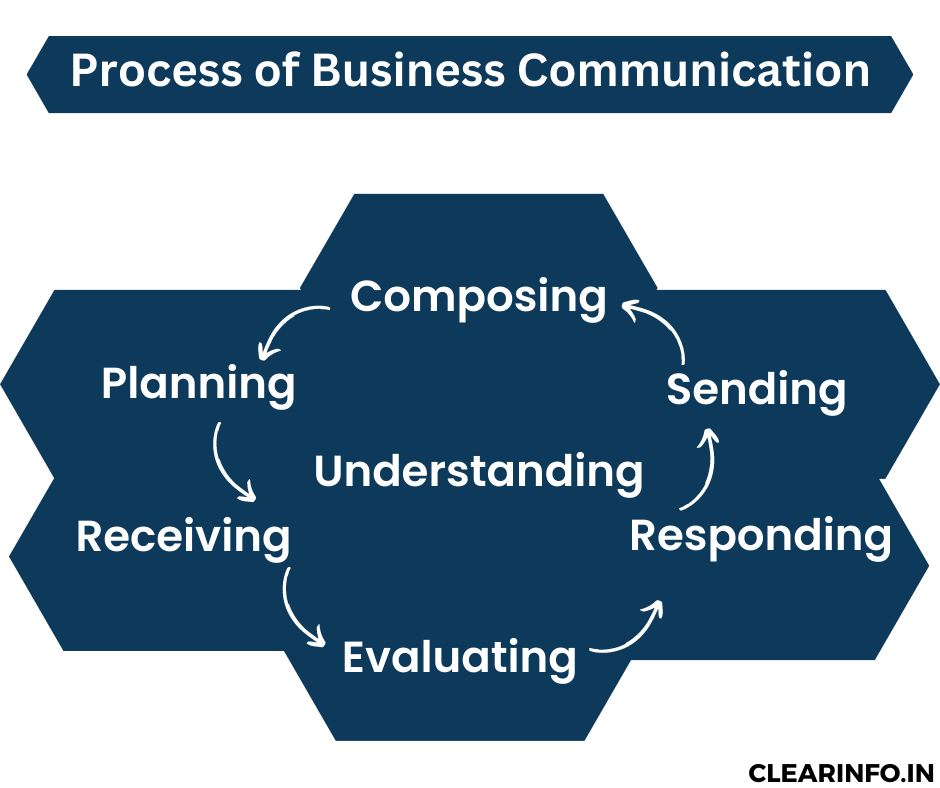
- Planning: Determining the purpose, audience, and key message of the communication, as well as the appropriate channel and timing.
- Composing: Creating the message, including selecting appropriate language, tone, and format, and organizing the information clearly and concisely.
- Sending: Transmitting the message through the chosen channel, such as email, phone call, or face-to-face conversation.
- Receiving: The recipient receives the message and decodes it, interpreting its meaning and relevance.
- Understanding: The recipient understands the message and its intended meaning, which may involve seeking clarification or additional information if needed.
- Responding: The recipient provides feedback or responds to the message, either verbally or in writing.
- Evaluating: Reflecting on the communication and assessing its effectiveness, including any areas for improvement or opportunities for further engagement.
Channels in business communication
Channels in business communication refer to the methods or mediums used to convey a message from the sender to the receiver. Communication channels can be categorized as either verbal or nonverbal and may comprise in-person discussions, telephone calls, video conferencing, and written records.
The choice of the communication channel can depend on various factors such as the type of message, urgency, audience, the sender’s preference, and the available technology.
1/ Email Communication: Email stands out as one of the most widely used communication channels in the business world. It’s fast, efficient, and can be used to communicate with a large group or send messages to specific individuals. Email in business communication can be used to request information, share updates, and even send attachments.
2/ Face-to-face communication: Although technology plays a significant role in business communication, there is no substitute for engaging in direct conversations. Face-to-face communication is essential for building relationships and establishing trust, and it allows you to read body language and understand reactions.
3/ Phone Calls: Phone calls are still an effective way to communicate in business. They remain relevant as they often give more context than an email and allow for clarification when needed.
4/ Video Conferencing: Video conferencing is a great way to communicate with people who are not in the same location. It’s ideal for meetings, and interviews and allows for a virtual face-to-face conversation with others.
5/ Text Messaging: Texts are often overlooked when it comes to business communication, but they’re quite useful. They can provide quick updates, resolve customer service issues, and confirm appointments. Many people typically respond quickly to text messages, making it an ideal communication tool, particularly when time is of the essence.
6/ Social Media: Social media serves as a highly effective platform for businesses to connect with their customers. It’s an effective way to share news, and promotions, and respond to customer inquiries quickly. Establishing a social media presence can also increase brand awareness, build customer engagement, and reduce marketing costs.
7/ Newsletters: The company newsletter is an excellent internal communication tool that can keep employees informed.- It can also serve as a marketing tool to promote your brand and products. You can use a Newsletter as a way to communicate new events, relative industry news, and updates.
8/ Memo: A memo is an ideal communication tool for an organization because it can be used to communicate concisely and straightforwardly. Memos are commonly used to communicate company updates, changes in policies, or work-related news.
9/ Webinars: Webinars are an ideal business communication channel for sharing your expertise and providing value to a broader audience. They’re a cost-effective way to educate, attract leads, and promote your brand. Webinars can establish your business’s authority, and promote the interest of your product or services.
10/ Blogs: Blogging is an excellent way to connect with your audience and establish your brand. Blogs can be used to educate your customers on industry-related news, and product features and provide solutions to their issues while demonstrating expertise in your field.
Methods of communication in business
Different methods of communication that businesses use to convey their messages, share information, and collaborate with others.
1/ Digital communication: This method involves the use of technology to communicate, such as through video conferencing, instant messaging, or social media. Digital communication is also beneficial for communicating with teams in remote locations.
2/ Mass communication: This method involves communicating with a large audience, such as through advertising, public relations, or marketing campaigns. It is useful for reaching a wide range of stakeholders and promoting the organization’s brand and reputation.
3/ Visual communication: Businesses often use visual aids for conveying information through images, such as graphs, charts, or videos. It is useful for presenting complex information or business data in a simple and easy-to-understand format.
4/ Interpersonal communication: This method involves communication between individuals in a face-to-face setting. It is useful for building relationships and fostering collaboration within the organization.
Related Reading: What are Interpersonal Barriers to Communication
What are the 7Cs in business communication?
The 7Cs in business communication are a set of principles that guide effective communication in a professional setting. These 7Cs are as follows:
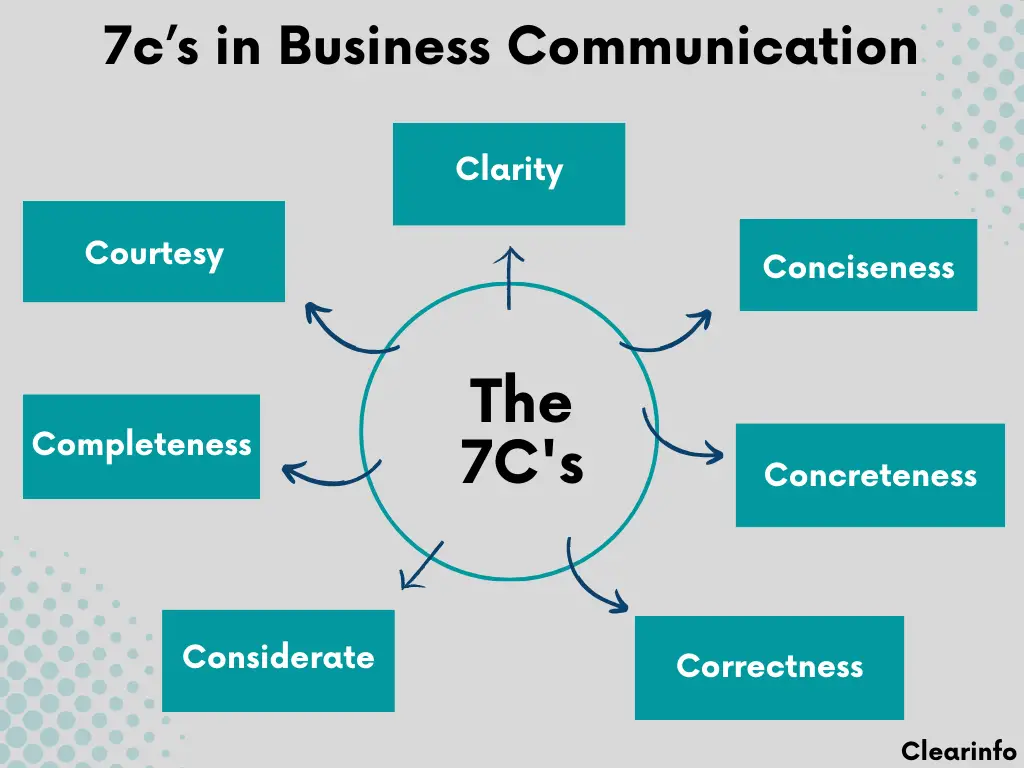
By following these 7Cs, businesses can ensure that their communication is effective, efficient, and professional, and helps to build strong relationships with customers, clients, and other stakeholders.
To know more check out our detailed article on: Principles of business communication with examples
Elements of business communication
The elements of business communication are the fundamental components that make up effective communication in a business setting. These elements include:
1/ Sender: The individual or organization that starts the communication process by generating and sending a message.
2/ Message: The information, ideas, or thoughts conveyed by the sender through various channels such as written documents, verbal exchanges, or multimedia.
3/ Channel: The methods utilized for transmitting the message, such as face-to-face discussions, telephone calls, electronic mail, or social media networks.
4/ Receiver: The person or entity who receives the message and interprets it.
5/ Feedback: The reply or feedback provided by the recipient to the message, which can be expressed either verbally or through nonverbal cues.
6/ Context: The circumstances or situation in which the communication takes place, including the physical, cultural, and social environment, as well as any external factors that may affect the message’s reception and interpretation.
7/ Encoding: The process by which the sender transforms the message into a suitable form for transmission, such as through language, symbols, or gestures.
8/ Decoding: The process by which the recipient comprehends the message and assigns meaning to it, based on their own knowledge, experiences, and cultural background.
9/ Noise: Any external or internal factors that interfere with the effective communication of a message. Noise can take various forms and may include physical barriers, psychological barriers, or semantic barriers
By understanding and applying these elements of business communication, organizations can improve their communication effectiveness, enhance relationships with stakeholders, and achieve their business objectives.
What is the importance of communication in business?
In the context of business, communication is a vital component that enables the smooth exchange of information among various stakeholders, including employees, clients, and partners. When communication is done effectively, it can help establish strong relationships and boost productivity.
In fact, a report by CMSWire states that 97% of employees believe communication has a significant impact on their daily working tasks.
Additionally, communication allows businesses to gain insights into the expectations and requirements of their stakeholders, identify issues, and address them efficiently. By promoting transparency and trust, clear communication can also help businesses maintain a positive reputation and attract new customers.
Importance of effective business communication
Effective business communication is crucial for achieving organizational goals and objectives. It enables clear and concise sharing of ideas, plans, and expectations among team members, clients, and partners. This enhances productivity, reduces errors, and promotes a positive working environment.
To know more check out our detailed article on: Importance of business communication for an organization
Purpose of business communication
Business communication aims to facilitate the transfer of information and messages among individuals or groups operating within a business environment. This helps to facilitate the smooth running of business operations, improve efficiency, and achieve organizational objectives.
Role of Manager in effective business communication
The role of the manager in effective business communication includes the following:
1/ Internal marketing is an important aspect of good business communication. Managers should ensure that employees’ well-being and work satisfaction are taken care of.
2/ Managers should keep track of changes in society and the ever-changing business environment to reflect these changes in communication processes within the business.
3/ Managers may have to work with difficult or unmotivated people, but with the right tools and effective communication principles, they can develop key business relationships in the workplace.
4/ Communication skills are essential for any management position as managers often have to deal with relational complexities involved in overseeing projects and directing a diverse group of individuals.
For instance, the manager may need to provide constructive feedback on an employee’s work performance, while on other occasions, they may have the opportunity to commend and acknowledge another employee’s exceptional performance.
According to the Harvard Business Review, 72% of employees believe that their performance could be enhanced if their managers offered corrective feedback, also referred to as “negative” feedback.
What are the barriers to business communication?
Obstacles that block the smooth transfer of information between individuals or groups operating within a business context are known as barriers to business communication. These barriers can also lead to miscommunication and poor communication within the business.
David Grossman’s report, The Cost of Poor Communications, which surveyed 400 large companies and 100,000 employees, found that communication barriers in the workplace result in an annual cost of $62.4 million per company.
Some common barriers to business communication include:
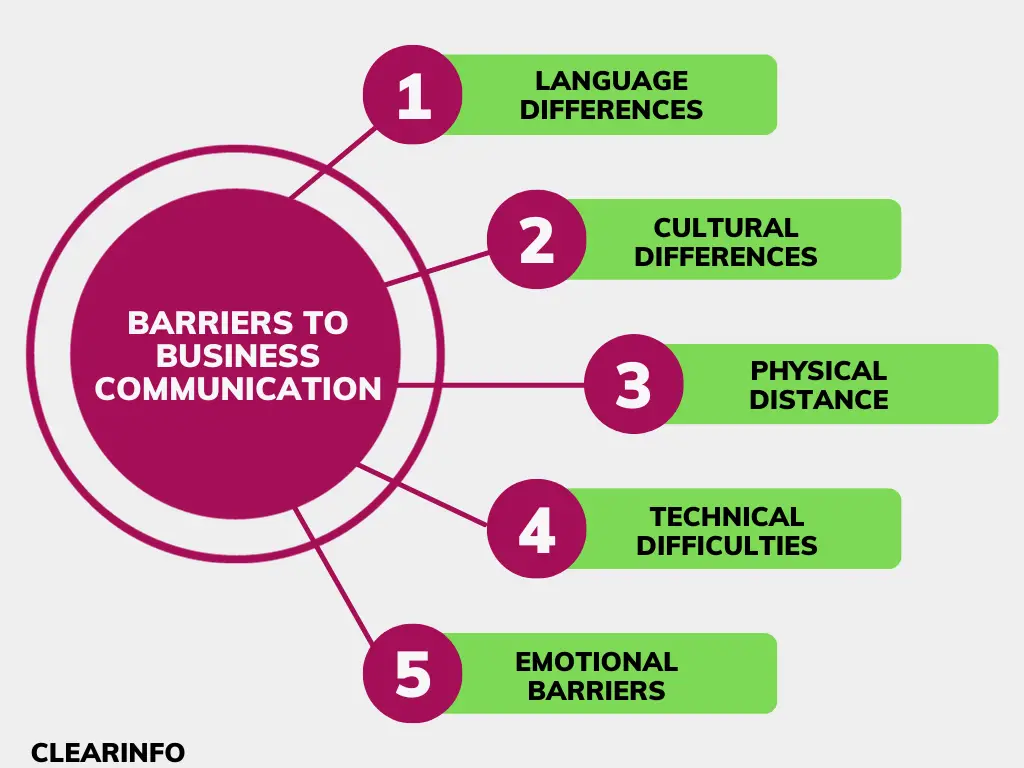
To know more check out our detailed article on: 10 Barriers to Business Communication & How to Overcome Them
What is the importance of business communication ethics?
Business communication ethics is important because it helps to establish trust, credibility, and accountability in business relationships. It is important to uphold these ethical standards to ensure that information is shared truthfully, transparently, and with integrity.
By doing this, a company can prevent misunderstandings, disputes, and legal problems that could harm its reputation and financial performance. In addition, ethical communication fosters a positive corporate culture, improves employee morale, and builds strong relationships with customers and other stakeholders.
To know more check out our detailed article on: Importance of ethics in business communication with examples
What are business communication skills?
Business communication skills refer to the abilities that individuals and organizations use to effectively convey information, ideas, and messages in a professional context.
These skills may include written communication, such as email, reports, and proposals, as well as verbal communication, such as presentations, meetings, and negotiations. Having good communication skills is vital in establishing robust connections with clients, staff, and stakeholders.
It also plays a critical role in encouraging cooperation and teamwork within an organization. In fact, the National Association of Colleges and Employers discovered that 73% of employers value employees who possess robust written communication abilities.
To know more check out our detailed article on: 10 skills for effective business communication
Examples of important business communication skills include:
- Active listening,
- Clarity of expression,
- Persuasion,
- Empathy,
- Diplomacy.
Using these, effective communication skills can also help to enhance productivity, reduce misunderstandings, and improve overall business performance.
Books on business communication
5 highly regarded business communication books:
1/ “Crucial Conversations: Tools for Talking When Stakes Are High” by Kerry Patterson, Joseph Grenny, Ron McMillan, and Al Switzler
This book offers practical advice and strategies for having difficult conversations in a business context. It provides tools for managing emotions, speaking persuasively, and reaching mutually beneficial outcomes.
2/ “Made to Stick: Why Some Ideas Survive and Others Die” by Chip Heath and Dan Heath
The focus of this book is to investigate the reasons why certain concepts have a greater impact and are more convincing than others. It offers practical tips for crafting messages that are clear, compelling, and easily understood by audiences.
3/ “The Art of Possibility: Transforming Professional and Personal Life” by Rosamund Stone Zander and Benjamin Zander
By highlighting the significance of creativity, inspiration, and possibility thinking, this book presents a new outlook on business communication. It provides practical advice for overcoming obstacles and achieving success in business and other areas of life.
4/ “Simply Said: Communicating Better at Work and Beyond” by Jay Sullivan
This book offers practical advice for improving communication skills in a business context. It covers topics such as active listening, clarity of expression, and building rapport with others.
5/ “HBR Guide to Persuasive Presentations” by Nancy Duarte
This book provides practical tips and techniques for creating and delivering effective business presentations. It covers topics such as storytelling, visual design, and delivery techniques.
To know more check out our detailed article on: Best books for business communication
How to improve business communication
Here are some of the top ways you can improve business communication
- Practice active listening
- Use clear and concise language
- Use appropriate tone and body language
- Provide context and background information
- Use different communication channels appropriately
- Practice empathy
- Be concise and to the point
- Seek feedback
- Invest in training and Practice
What are some best business communication tools?
Having the right communication tools is important whether you’re collaborating with team members, communicating with clients or customers, or managing projects. In this list, we’ve compiled some of the best business communication tools that can help you streamline your communication processes:
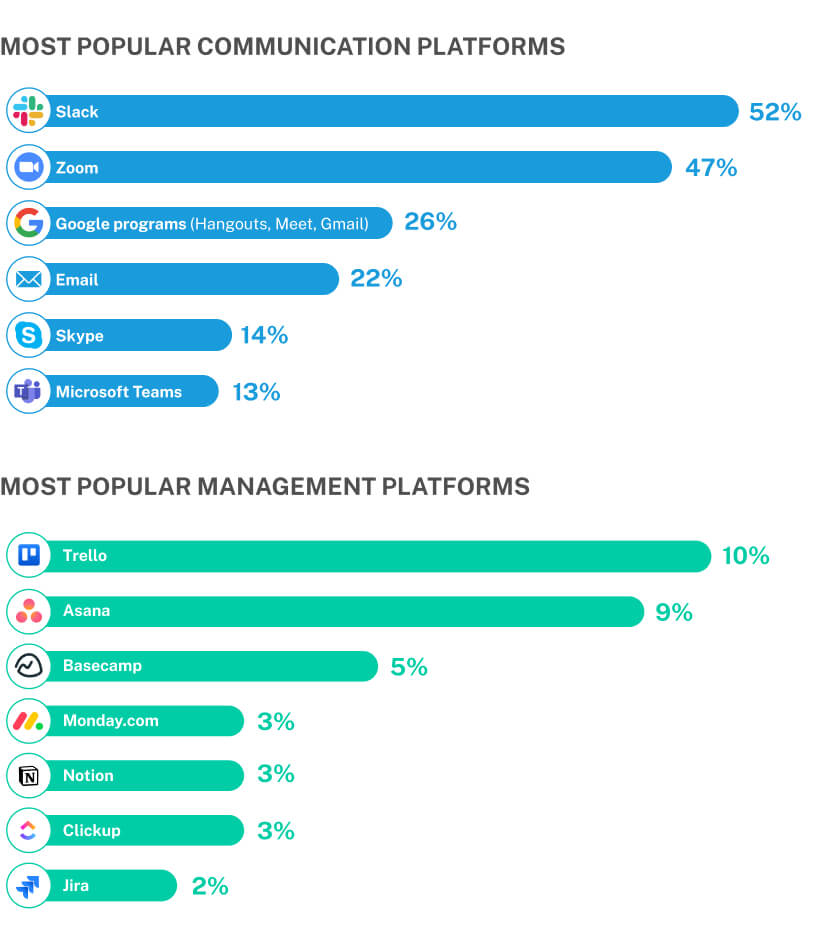
Further Reading: 20 Best Business Communication Tools (Tested + User Reviews)
Report writing in business communication
Report writing in business communication is the process of creating a formal document that provides information, analysis, and recommendations on a particular topic or issue.
A report typically includes several key elements, including an introduction that explains the purpose and scope of the report, a body that presents the findings or analysis, and a conclusion that summarizes the main points and provides recommendations or next steps.
Reports may also include other elements such as tables, graphs, or charts to help illustrate key points, as well as appendices that provide additional details or supporting information.
Types of reports in business communication
Several different types of reports are commonly used in business communication, each with its own specific purpose and format. Here are some of the most common types of reports:
- Informational Reports: These reports are used to convey information on a particular topic or issue, such as market research or progress updates.
- Analytical Reports: The purpose of these reports is to analyze data and information to generate recommendations and insights.
- Feasibility Reports: These reports are utilized to assess the viability of a specific project or concept. They typically include an analysis of potential costs, risks, and benefits.
- Progress Reports: The purpose of these reports is to provide progress updates regarding ongoing projects.
- Recommendation Reports: These reports provide recommendations for a particular course of action, often based on research and analysis.
To know more check out our detailed guide on: Types of business reports in business communication
Presentation topics for business communication
A well-chosen topic can help capture the audience’s attention and provide valuable insights and information. Some impactful presentation topics for business communication include:
- Time Management and Productivity in the Workplace
- Creating and Delivering Effective Business Presentations
- Conflict Resolution Strategies for Business Teams
- Tips for Effective Business Writing
- Strategies for Successful Business Negotiation
- Strategies for Employee Engagement and Retention
However, when selecting a presentation topic, it’s important to consider the interests and needs of the audience, as well as the goals of the presentation.
To know more check our detailed article on: Best topics for business communication presentation
Difference between business communication and other communication
The above table highlights some key differences between business communication and other types of communication.
Differentiating Aspect | Business Communication | Other Communication |
Purpose | To achieve business objectives. | To exchange information or ideas. |
Audience | Internal and external business stakeholders. | Anyone. |
Tone | Professional and formal. | Informal and casual. |
Format | Structured and formal documents. | Varied formats, such as emails, texts, or social media messages. |
Content | Business-related information, such as proposals, reports, or memos. | Personal or social information, such as greetings, small talk, or sharing of experiences. |
Feedback | Often formal and structured, such as performance reviews or customer feedback. | Informal and less structured, such as reactions or responses to social media posts. |
Channels | Traditional, such as letters or meetings, and digital, such as email or video conferencing. | Varied, depending on the medium used, such as phone, text, or social media platforms. |
Consequences | Can have a significant impact on business outcomes, such as sales, profits, or reputation. | May have social or personal consequences, but generally less significant than business communication. |
To know more check out our detailed article on: Business communication vs General communication
Frequently Asked Question
Q1) What do you mean by business communication?
Ans: Business communication is the process of exchanging information, and messages within and between organizations for the purpose of achieving specific business goals.
Q2) What are the 4 types of business communication?
Ans: The four types of business communication are upward communication, downward communication, horizontal communication, and external communication. For an organization to be proficient they need all four types of communication to effectively and achieve their goals.
Q3) What are the 4 pillars of business communication?
Ans: The four pillars of business communication are clarity, conciseness, completeness, and correctness. These pillars are essential for effective business communication, as they help to ensure that messages are transmitted successfully.
Q4) What are the 5 parts of business communication?
Ans: The five parts of business communication are opening, body, context, conclusion, and closing. These five parts help to structure business communication effectively, ensuring that messages are clear and complete.



